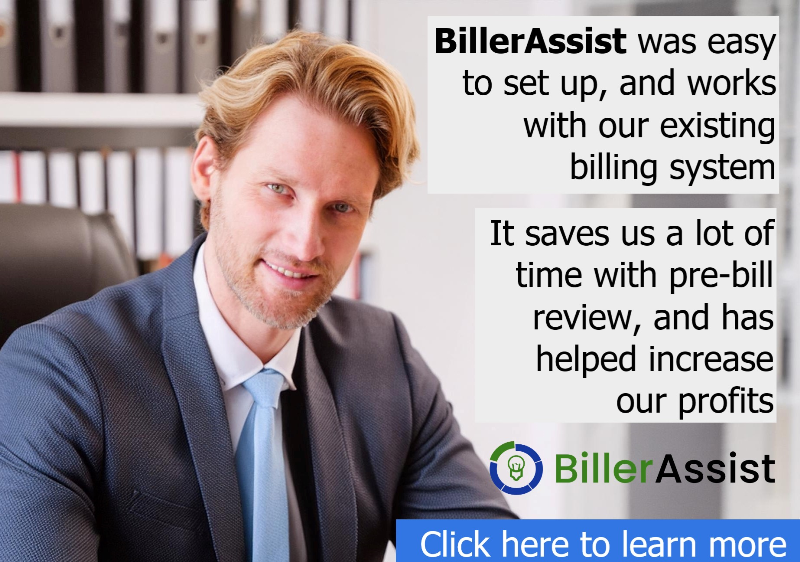How Billing Optimization Can Increase Revenue
The vast majority of law firms use some sort of digital or computerized billing or practice management system.
However, not all such systems are created equal. New technological advances have made for easier and more accurate billing.
Even more recently, developments in machine learning and artificial intelligence allow law firm billing and practice management systems to intuit and adapt to their users.
These new “computer assisted billing” applications can help grow a law firm’s revenue.
Automate Billing Review
Billing clients is a time-consuming task that unfortunately adds to an attorney’s already busy workload. Unlike many other tasks, billing is not a task an attorney can bill for. All the time spent dealing with time entry and invoicing could be going toward billable activities, or to the attorney’s free time.
The Un-Billable Hour, a law practice and advisory podcast, confirms that inefficiencies related to un-billable tasks cost law firms money. The podcasts specifically addresses “disorganization, slow response to clients, late billing invoices and not tracking time” as the principal causes of decreased efficiency and lower revenue.
Although there are many applications that at least claim to streamline the time-entry part of the billing process, these same applications typically neglect the bill review portion of bill submission.
In addition, most time tracking and billing systems are unable to cross-reference firm billing practices with client requirements to ensure irregularities are addressed, a process that can be equally time-consuming.
However, the latest automated billing applications, aided by artificial intelligence and machine learning, address these issues.
These applications can learn a firm’s billing practices and provide real-time notifications to timekeepers to assure ongoing compliance.
Moreover, these applications can also highlight billing irregularities in relation to client billing rules and requirements, alerting law firms to potential issues as work is being done.
With this real-time actionable information, each timekeeper can better allocate their activities to comply with client requirements, and even avoid doing work for which a client is not likely to pay.
Automate UTBMS/LEDES Coding
About twenty years ago, the Legal Electronic Data Exchange Standard Oversight Committee (LOC), created a system for billing standardization to better classify legal tasks and expenses. The LOC also made a formatting system to translate them to invoices. Flash forward and the requirement of UTMBS or “LEDES” codes by various types of clients has become more or less the norm.
To their credit, since their implementation, the LOC’s standardization efforts have provided increased transparency and helped clients to better interpret and understand their bills.
Unfortunately, the actual application of these codes consists of searching for and selecting entries in billing system pulldown menus, making a tedious task all the more so.
The increase in the time expended on the process of entering time, coupled with human error mistakes and idiosyncratic code selections, creates problems at nearly every level of the processes.
Clients will sometimes reject invoices due to incorrect coding, and the additional time it takes to get it right cuts deeper and deeper into already limited hours available for billable activities.
Fortunately, automated billing applications specifically designed for UTBMS codes and LEDES formatting help handle these inefficiencies.
These applications can accurately and automatically affix the proper codes with the corresponding tasks or expenses.
Lawyers no longer have to look up codes, or deal with the consequences of selecting the wrong ones. “Computer assisted billing” applications now take care of the codes in a standardized manner.
Decrease “Days Sales Outstanding” (DSO)
Finding and addressing weak points is an integral part of management. Although inefficiencies aren’t ideal in any aspect of a law firm’s business, they can be especially damaging when dealing with billing. Proper billing is one of the things law firms have to do just right, every time, or it can cost them money or even worse.
It’s not unreasonable to assume that the faster and more accurately invoices can be submitted, the faster the law firm can get paid. If this holds true, all else being equal, better billing practices should yield improved cash flows and increased profits.
The Un-Billable Hour has a way of determining if this theory holds water. It consists of checking how long it takes to draft a bill versus how long it takes for a bill to be paid.
If Days Sales Outstanding (DSO) or the average number of days it takes to collect payments after invoice submission is lowered after implementing better billing practices, the reasons will be self-evident. If not, at least better billing practices were put in place.
Attorneys can calculate their firm’s DSO with this formula:
(Accounts Receivable / Total Revenue) x Number of Days
Automated billing applications improve DSO because they provide faster, more transparent billing with fewer mistakes that can trip up and slow down the billing and repayment process.
Moreover, the AI found in these applications alerts the user to potential problems, before a law firm’s invoices are even generated.
Conclusion
Technology is changing the legal landscape. Tools that are cutting-edge and optional today will be a required aspect of “technology competency” requirements tomorrow. Automated billing not only innovates on the inefficiencies of manual billing but also the limitations of less-advanced billing software.
The benefits are clear. Attorneys can free up more time for billable tasks, have fewer rejected bills due to inaccuracies or coding errors, and even find new ways to improve their business from analysis of their billing data. All of these features are designed to help drive realization and collection rates, and ultimately increase the firm’s profits.




